Drafts by Pernille Eskerod
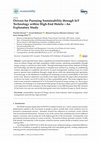
Sustainability, 2019
A growing hotel sector makes a significant environmental footprint. Due to a contemporary focus o... more A growing hotel sector makes a significant environmental footprint. Due to a contemporary focus on climate change and high competition within tourism, enhancing sustainability through energy savings is a priority for many hotels. Through technological innovations, Internet-of-Things (IoT) technology provides the opportunity to integrate more systems (e.g., heating, airconditioning , window-openings) on a platform (also known as smart management), making it easy for a hotel guest to operate room conditions through a single device while also optimizing hotel operations. A research gap on the likelihood of adopting IoT technology to pursue sustainability in the hotel sector exists. Based on explorative case studies of five high-end hotels, this paper offers propositions on drivers for hotels' use of IoT to deliver on their sustainability goals. This study suggests that a hotel is more inclined to implement IoT if (1) the hotel is focused on energy savings, e.g., due to green certificates; (2) it belongs to an international hotel group; (3) decision makers perceive sustainability to be important for their customers; (4) the target group is more B2B (business) than B2C (leisure); (5) the hotel a five star one; and (6) the hotel guests come from Northern Europe or North America.
Papers by Pernille Eskerod
25th Nordic Academy of Management Conference: Nordic Energies, Aug 22, 2019
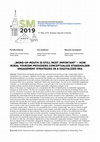
Globalization and digitalization affect the individual rural tourism provider's relationship with... more Globalization and digitalization affect the individual rural tourism provider's relationship with the stakeholders (e.g. customers, suppliers). For example, customers compare prices online, book their holidays via distribution platforms (e.g. booking.com) and rate their holidays on a farm anonymously via online websites. The increasing digitalization of provider-customer relationships may lead to resistance against digitalization among rural tourism providers due to persistent "traditional" beliefs and "mental maps", but also to new stakeholder engagement strategies, e.g. around digital platforms. However, a research gap on the views and experiences of individual rural tourism providers and their preferred (digital) stakeholder engagement strategies exists. Hence, in this paper our research goal is to conceptualize the effect of digitalization on stakeholder engagement strategies in "rural tourism". We base the conceptual analysis on a revision of the theoretical building blocks rural tourism, stakeholder engagement and mental maps in order to derive propositions for further empirical research and for a (comparative) case study-analysis of rural tourism providers in Austria and Serbia. Our literature review highlights the relationship between the tourism provider and the customers as key stakeholders; it also sheds lights on (potential) differences in the understanding of rural tourism across sub-concepts and countries: We conceptualize how rural tourism providers offer personalized experiences and close interaction with the rural life through various culturespecific sub-concepts like slow tourism, agritourism, ecotourism etc. In the case of rural tourism, we argue that establishing relationships via word-of-mouth and maintaining long-term intensive relationships built on reciprocal trust is crucial, as this type of tourism builds-to a great extent-on extensive interactions between the local community and the tourist. Moreover, we conceptualize how existing "mental maps" may act as a barrier to adopt new forms of distribution channels and customer contact despite a potential competitive advantage (e.g. through booking.com and holiday-on farm websites). Based on this literature review we derive five propositions for further research on rural tourism providers in Austria and Serbia. Amongst other propositions, we argue that the understanding and the (digital) strategies around "rural tourism" differ among the countries. Moreover, we propose that the more successful the rural tourism providers have been with traditional/classical communication channels the less likely it is that they will embrace digitalization in their stakeholder engagement strategies. Finally, we propose that new digital forms of stakeholder engagement strategies (e.g. via platforms) have to be combined with "traditional" engagement strategies (e.g. word-of-mouth) in order to gain a competitive advantage. We close the analysis with a brief outlook on preliminary results of our study, which point to the high importance of "traditional" strategies (wordof-mouth) for attracting customers.
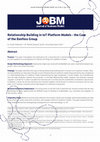
Purpose: This paper investigates the implications for a manufacturer’s relationship building towa... more Purpose: This paper investigates the implications for a manufacturer’s relationship building towards B2B customers and suppliers as a consequence of Internet-of-Things (IoT) platform models. Design/methodology/approach: Explorative single case study with embedded sub-cases. Qualitative research approach. Semi-structured interviews. Findings: The paper identifies two ways of doing relationship building when it comes to IoT platform models. Relationship building can take place through a Classic Relationship IoT platform model (characterized by low complexity) or a New Relationship IoT platform model (characterized by high complexity). In both models, the manufacturer aims for high stickiness towards the customers. In the New Relationship model, however, low stickiness towards suppliers is aimed for in order to enable the manufacturer to orchestrate the stakeholder constellation dynamically. In addition, a driver for the low stickiness aim towards suppliers can be found in a motive to ...

Anali Ekonomskog fakulteta u Subotici, 2020
In order to achieve successful positioning, rural tourism managers and marketers need to understa... more In order to achieve successful positioning, rural tourism managers and marketers need to understand consumer behaviour. Above all, they need to answer the question of which customer profiles are suitable to particular tourist destinations There are three types of statistical measurement used for research into consumer, i.e. tourist behaviour, and those are volume, value and profile. A profile encompasses characteristics of the consumers per se and characteristics of trae. The aim of the paper is to define the profile of rural tourism consumer based on the results of the conducted research, taking into account two socio-demographic characteristics of the consumers - age and education level in relation to three characteristics of travel - frequency of engaging in rural tourism, travel companions and information sources used to plan the trip. The research encompassed 150 respondents each from Serbia and Austria respectively. Cross-tabulation method was used for testing the set hypotheses.

Project Leadership and Society, 2021
In this article we present findings from an investigation into the influence of partnering succes... more In this article we present findings from an investigation into the influence of partnering success factors on multipartner projects' abilities to meet time schedule, budget, and technical specifications. Our findings are based on the analysis of nationwide surveys within the engineering consultancy industry in Denmark and Norway, and the research includes empirical data from 124 engineering consultancies. A main conclusion is that in order to meet all three criteria in the project performance measure, i.e. time schedule, budget, and technical specifications, mutual project objectives and commitment are important. To fulfil the two criteria time schedule and technical specifications, trust and collaborative problem-solving are important. To meet the criterion technical specifications, communication is the important partnering success factor. We also find that to positively influence project performance in a project comprising partners from independent firms, the project manager must aim to ensure the presence of the five identified partnering success factors throughout the project.
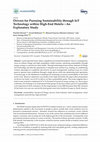
Sustainability, 2019
A growing hotel sector makes a significant environmental footprint. Due to a contemporary focus o... more A growing hotel sector makes a significant environmental footprint. Due to a contemporary focus on climate change and high competition within tourism, enhancing sustainability through energy savings is a priority for many hotels. Through technological innovations, Internet-of-Things (IoT) technology provides the opportunity to integrate more systems (e.g., heating, air-conditioning, window-openings) on a platform (also known as smart management), making it easy for a hotel guest to operate room conditions through a single device while also optimizing hotel operations. A research gap on the likelihood of adopting IoT technology to pursue sustainability in the hotel sector exists. Based on explorative case studies of five high-end hotels, this paper offers propositions on drivers for hotels’ use of IoT to deliver on their sustainability goals. This study suggests that a hotel is more inclined to implement IoT if (1) the hotel is focused on energy savings, e.g., due to green certificat...
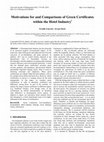
Universal Journal of Management, 2018
A blooming hotel industry has the downside of an increased negative environmental impact. At the ... more A blooming hotel industry has the downside of an increased negative environmental impact. At the same time, many hotel guests and employees have become conscious of eco-friendliness and green practices. In addition, 2017 was by United Nations declared as the International Year of Sustainable Tourism for Development, with the emphasis on (among other elements) resource efficiency and environmental protection. A hotel that has obtained green certificate(s) promises green services, products, and operations, and possesses thereby (potentially) important strategic assets, when it comes to attracting customers and employees. Many green certifications are offered within the hotel industry, such as for example Green Globe and Green Key. However, which certificate(s) to choose is a strategic choice for the hotel management. In this paper, we examine green certifications in order to determine similarities and differences among them. As part of the research, we analyze the usage of green certificates in different regions (e.g. Southeast Europe). Even though many of the certifications are offered internationally, we identified clear differences in dissemination across regions. In addition to region, our motivation factor analysis shows that belonging to a hotel chain/brand seems to be highly influential on the choice of certificate(s).

International Journal of Managing Projects in Business, 2018
Purpose Exploitation of project opportunities may bring more benefits than stipulated in the init... more Purpose Exploitation of project opportunities may bring more benefits than stipulated in the initial business case, and even stakeholder benefits that nobody thought of at the project initiation. The purpose of this paper is to suggest a new research area for megaprojects, i.e. the phenomenon of project opportunity exploitation as a means to increase the project benefits. Design/methodology/approach This is a single case study of an infrastructure megaproject, i.e. the construction and operation of a 50+ years old American bridge. Data cover information regarding 60+ years old historical documents, newspaper articles, interviews and video-recordings. Findings The findings of this paper are as follows: exploiting all opportunities created by the project and increasing project benefits require involvement from many categories of stakeholders; stakeholders get more involved in exploiting the opportunities created by the project when they are proud of the project; for some of the projec...
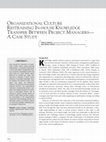
Project Management Journal, 2007
Even though the importance of knowledge transfer within project-oriented organizations is frequen... more Even though the importance of knowledge transfer within project-oriented organizations is frequently emphasized in the recent project management literature, in practice, knowledge transfer only takes place to a rather limited extent. Based on an in-depth case study, findings from a company, in which several initiatives to promote knowledge transfer between five full-time project managers were taken, are presented. However, the initiatives did not bring the expected outcome. The organizational subculture encompassing project managers may explain reluctance in involvement in knowledge transfer and in sharing of lessons learned. Based on Schein's notion (1987) six basic underlying assumptions in the organizational culture that limit knowledge transfer are identified. Further, the authors propose an interaction paradigm underlying project managers' interactions.
Project Management Journal, 2017
By definition, megaprojects consume numerous resources and impact numerous people, even across ge... more By definition, megaprojects consume numerous resources and impact numerous people, even across generations; it is therefore important that they bring considerable value to their initiators and other stakeholders. Based on stakeholder value construct frameworks identified in the literature and a single case study of the construction and operations of an over 50-year-old American highway bridge, we identify ways to understand, classify, and express megaproject stakeholder value. The research links different stakeholder types to types of value constructs. Knowing which types of value constructs matter to different stakeholder types could potentially help project representatives communicate more efficiently and effectively.

International Journal of Workplace Health Management, 2017
Purpose The purpose of this paper is to address a missing link between top management and employe... more Purpose The purpose of this paper is to address a missing link between top management and employees when it comes to understanding how to successfully implement and embed workplace health promotion (WHP) as a strategy within organizations: the role of the middle managers. Design/methodology/approach A conceptual framework based on review of theory is applied within an empirical multi-case study that is part of a health intervention research project on increased physical activity among office workers. The study involves six Danish organizations. Findings Middle managers play a key role in successful implementation of WHP, but feel uncertain about their role, especially when it comes to engaging with their employees. Uncertainty about their role appears to make middle managers reluctant to take action on WHP and leave further action to top management instead. Research limitations/implications Limitations included the middle managers’ low attendance at the half-day seminar on strategic...
Project Management Journal, 2015
According to research, stakeholder disappointment is a root problem within projects. In this arti... more According to research, stakeholder disappointment is a root problem within projects. In this article, the dilemmas related to stakeholder inclusiveness, in other words, engaging a broad range of stakeholders, are discussed. Based on a longitudinal case study, three propositions are offered: Applying stakeholder inclusiveness in a project (1) increases the likelihood of more engaged and satisfied stakeholders; (2) increases the danger of losing focus on those stakeholders who possess the most critical resources for the project's survival and progress; and (3) increases the danger of inducing stakeholder disappointment due to expectation escalation and impossibility of embracing conflicting requirements and wishes.
ESI International Project Management Series, 2013
Findings from examining eleven knowledge sharing activities in five mature project-oriented organ... more Findings from examining eleven knowledge sharing activities in five mature project-oriented organisations are presented. Based on in-depth case studies, we claim that mature project-oriented companies will prefer knowledge sharing activities that contribute to an intra-organisational common frame of reference. Further, activities that are internal to the companies are preferred to external activities, and non-project-/programme-specific knowledge sharing activities are preferred to project-/programme-specific knowledge sharing activities
Project Management Journal, 2014
In stakeholder management, a key question is: How can an actor/organization (e.g., a project) und... more In stakeholder management, a key question is: How can an actor/organization (e.g., a project) under different contingencies apply strategies to develop the relationship with each stakeholder into a favorable one seen from the focal organization's perspective? Based on an in-depth longitudinal case study, we provide detailed descriptions of how a project management team worked with its stakeholder relationships. Applying a practice approach, we explore how stakeholder management practices emerged and evolved as embedded actions and interpretations related to perceptions of each stakeholder's harm and help potentials. We show how trust was both input to and outcomes of the managerial action.

International Journal of Managing Projects in Business, 2015
Purpose – Despite good project front-end planning, projects typically need continuous coordinatio... more Purpose – Despite good project front-end planning, projects typically need continuous coordination among the participants concerning scope of work, pace, and timing during the execution phase to be accomplished without delays. Coordination can be formal or informal. Research shows that informal coordination of residual and unforeseen interdependencies enhances time saving and facilitates better understandings. Still though, many sub-contractors choose not to coordinate informally. The purpose of this paper is to identify drivers that enhance or inhibit informal coordination among sub-contractors during project execution. Design/methodology/approach – A qualitative, explorative case study approach was applied, involving 15 SME sub-contractors within the offshore wind power energy sector. Findings – Six drivers which enhance informal coordination and three drivers which inhibit informal coordination among sub-contractors in projects were identified. Practical implications – The findin...


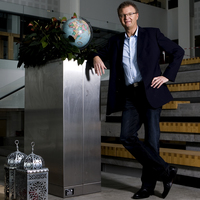







Uploads
Drafts by Pernille Eskerod
Papers by Pernille Eskerod